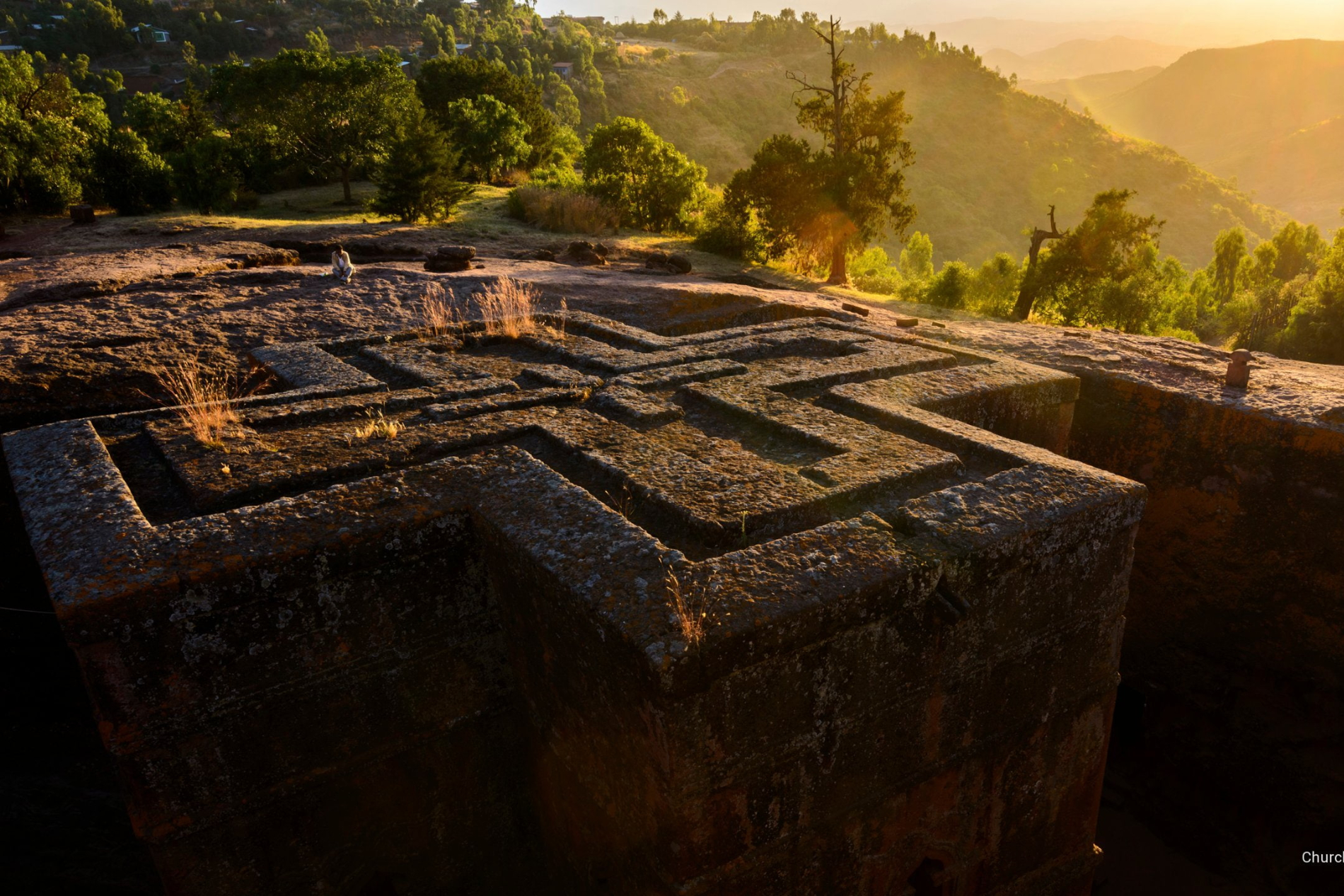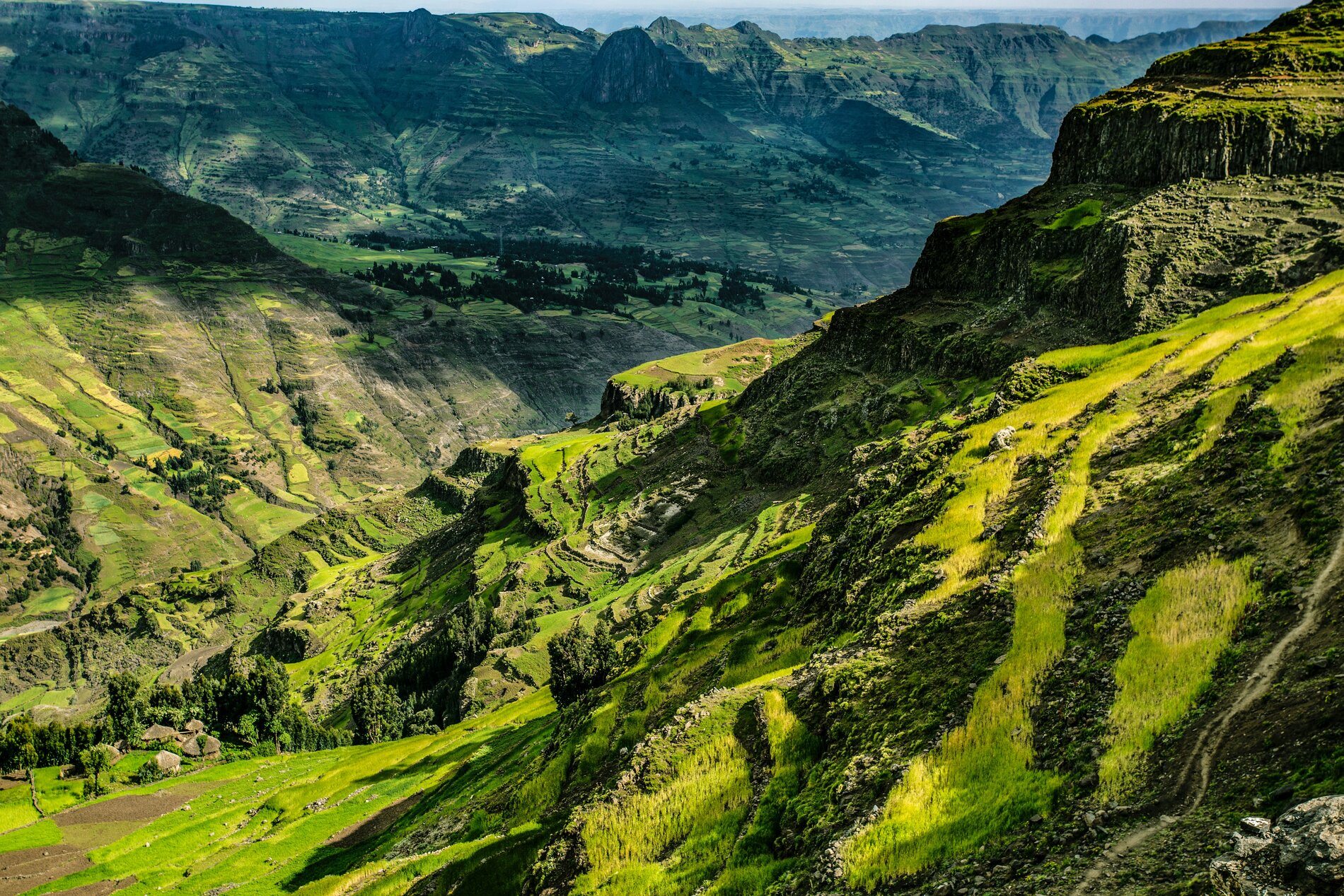BABYLON
Ethiopia, in the Horn of Africa, is a rugged, landlocked country split by the Great Rift Valley. With archaeological finds dating back more than 3 million years, it’s a place of ancient culture. Among its important sites are Lalibela with its rock-cut Christian churches from the 12th–13th centuries.
Ethiopia
Ethiopia, country on the Horn of Africa. The country lies completely within the tropical latitudes and is relatively compact, with similar north-south and east-west dimensions. The capital is Addis Ababa (“New Flower”), located almost at the centre of the country. Ethiopia is the largest and most populated country in the Horn of Africa. With the 1993 secession of Eritrea, its former province along the Red Sea, Ethiopia became landlocked.
Ethiopia is one of the world’s oldest countries, its territorial extent having varied over the millennia of its existence. In ancient times it remained centred on Aksum, an imperial capital located in the northern part of the modern state, about 100 miles (160 km) from the Red Sea coast. The present territory was consolidated during the 19th and 20th centuries as European powers encroached into Ethiopia’s historical domain. Ethiopia became prominent in modern world affairs first in 1896, when it defeated colonial Italy in the Battle of Adwa, and again in 1935–36, when it was invaded and occupied by fascist Italy. Liberation during World War II by the Allied powers set the stage for Ethiopia to play a more prominent role in world affairs. Ethiopia was among the first independent nations to sign the Charter of the United Nations, and it gave moral and material support to the decolonization of Africa and to the growth of Pan-African cooperation. These efforts culminated in the establishment of the Organization of African Unity (since 2002, the African Union) and the United Nations Economic Commission for Africa, both of which have their headquarters in Addis Ababa.
Ethiopia’s topography, one of the most rugged in Africa, is built on four geologic formations. Rocks of Precambrian origin (more than 540 million years in age) form the oldest basal complex of Ethiopia, as they do in most of Africa. The Precambrian layer is buried under more recent geologic formations—except in parts of northern, western, and southern Ethiopia, where there are exposed rock layers of granite and schist. Geologic processes of the Mesozoic Era (about 250 to 65 million years ago) contributed sedimentary layers of limestone and sandstone, most of which have been either eroded or covered by volcanic rocks. Younger sedimentary layers are found in northern Ethiopia and on the floors of the Rift Valley. Lava flows from the Cenozoic Era (i.e., the past 65 million years) have formed basaltic layers that now cover two-thirds of Ethiopia’s land surface with a thickness ranging from about 1,000 feet (300 metres) to almost 10,000 feet (3,000 metres). The Rift Valley forms a spectacular graben (a massive tectonic trough) running right down the middle of the country from the northern frontier with Eritrea to the southern border with Kenya. Although Ethiopia’s complex relief defies easy classification, five topographic features are discernible. These are the Western Highlands, the Western Lowlands, the Eastern Highlands, the Eastern Lowlands, and the Rift Valley. The Western Highlands are the most extensive and rugged topographic component of Ethiopia. The most spectacular portion is the North Central massifs; these form the roof of Ethiopia, with elevations ranging from 14,872 feet (4,533 metres) for Mount Ras Dejen (or Dashen), the highest point in Ethiopia, to the Blue Nile and Tekeze river channels 10,000 feet below. Lake Tana—Ethiopia’s largest inland lake and the main reservoir for the Blue Nile River—is located in this region, at an elevation of about 6,000 feet (1,800 metres).
Witten by Donald Edward Crummey
Places
Ethiopia is known as the Cradle of Mankind, with some of the earliest ancestors found buried in the soil. Lucy (3.5 million years old), the most famous fossils found, were unearthed in Hadar. Ethiopia remains one of the only nations in Africa never to be colonized.

The Blue Nile Falls
The Blue Nile Falls is a waterfall on the Blue Nile river in Ethiopia. It is known as Tis Abay in Amharic, meaning "great smoke". It is situated on the upper course of the river, about 30 km downstream from the town of Bahir Dar and Lake Tana. The falls are one of Ethiopia's best known tourist attractions

Simien Mountains National Park
Simien Mountains National Park is in northern Ethiopia. Its rugged terrain includes escarpments, deep valleys and a high plateau, home to rare Walia ibex and Gelada baboons. Tall peaks include the towering Ras Dashen mountain. Trails wind through the park to camps at Sankaber, Geech and Chenek. The central Gidir Got and Imet Gogo summit lookouts have panoramic views of sheer cliffs and the lowlands below.

Erta Ale
Erta Ale is a continuously active basaltic shield volcano in the Afar Region of northeastern Ethiopia. It is situated in the Afar Depression, a badland desert area. Erta Ale is the most active volcano in Ethiopia.
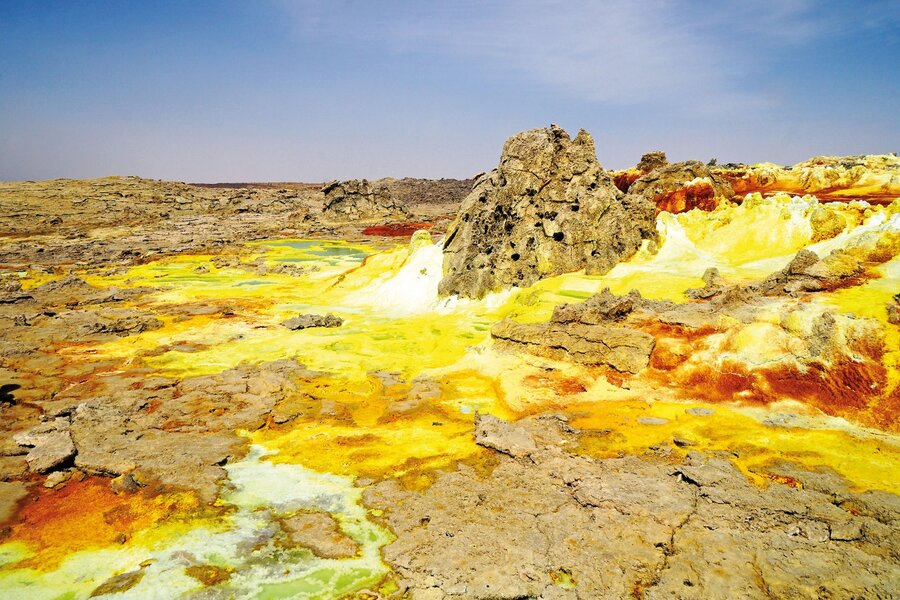
The Danakil Depression
The Danakil Depression is the northern part of the Afar Triangle or Afar Depression in Ethiopia, a geological depression that has resulted from the divergence of three tectonic plates in the Horn of Africa.

The National Museum of Ethiopia
The National Museum of Ethiopia, also referred to as the Ethiopian National Museum, is a national museum in Ethiopia. It is located in the capital, Addis Ababa, near the Addis Ababa University's graduate school.

Ras Dejen
Ras Dejen, also known as Ras Dashen, is the highest mountain in Ethiopia and tenth highest mountain of Africa. Part of Semien Mountains National Park located in the Amhara Region, it reaches an elevation of 4,550 metres.

The Bale Mountains
The Bale Mountains, in the Oromia Region of southeast Ethiopia, south of the Awash River, are part of the Ethiopian Highlands. They include Tullu Demtu, the second-highest mountain in Ethiopia, and Mount Batu. The Weyib River, a tributary of the Jubba River, rises in these mountains east of Goba.

Mount Entoto
Mount Entoto is the highest peak on the Entoto Mountains, which overlooks the city of Addis Ababa, the capital of Ethiopia. It reaches 3,200 meters above sea level.

Awash National Park
Awash National Park is a national park in Ethiopia. Spanning across the southern tip of the Afar Region and the northeastern corner of the Misraq Shewa Zone of Oromia, this park is 225 kilometers east of Addis Ababa (and a few kilometers west of Awash), with its southern boundary along the Awash River, and covers 756 square kilometers of acacia woodland and grassland.

Church of Saint George
The Church of Saint George is one of eleven rock-hewn monolithic churches in Lalibela, a city in the Amhara Region of Ethiopia. Originally named Roha, the historical and religious site was named Lalibela after the King Gebre Mesqel Lalibela of the Zagwe dynasty, who commissioned its construction.

Fasil Ghebbi
The Royal Enclosure is the remains of a fortress-city in Gondar, Ethiopia. It was founded in the 17th century by Emperor Fasilides and was the home of Ethiopia's emperors. Its unique architecture shows diverse influences including Nubian styles. The site was inscribed as a UNESCO World Heritage Site in 1979.

Dallol
Dallol is a locality in the Dallol woreda of northern Ethiopia. Located in Administrative Zone 2 of the Afar Region in the Afar Depression, it has a latitude and longitude of 14°14′19″N 40°17′38″E with an elevation of about 130 metres below sea level.
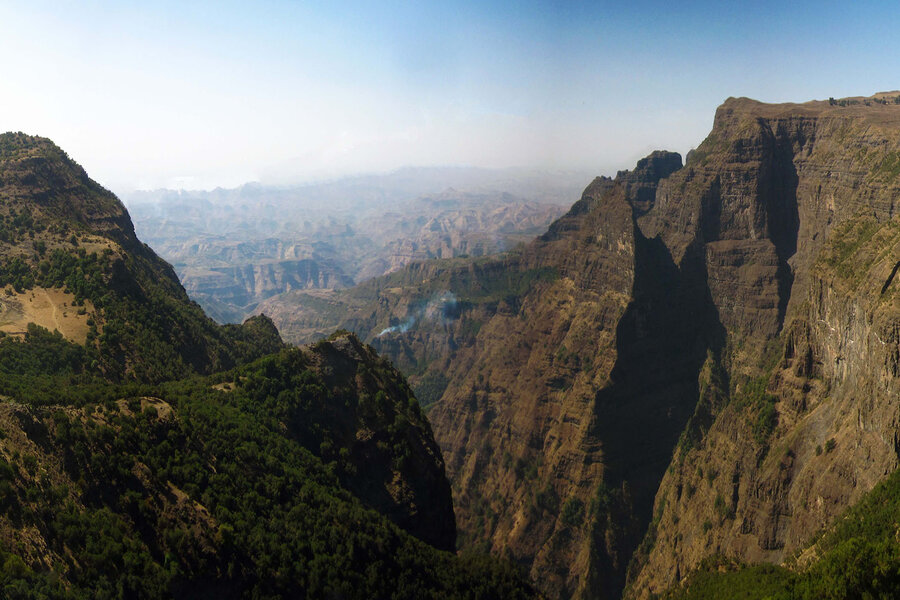
Mago National Park
Mago National Park is a national park in Ethiopia located in the Southern Nations, Nationalities, and Peoples' Region about 782 kilometers south of Addis Ababa and north of a large 90° bend in the Omo River, the 2162 square kilometers of this park are divided by the Mago River, a tributary of the Omo, into two parts.

Nechisar National Park
Nechisar National Park is in southwest Ethiopia. Its varied terrain spans escarpments, swamps and forest. Zebras and gazelles roam the vast savannahs of the Nechisar Plains. The large, brown-red Lake Abaya sits on the north side of the mountainous "Bridge of God" isthmus. To the south is Lake Chamo, known for its big Nile crocodiles. The park is home to many birds, including the rare Nechisar nightjar.

Abijatta-Shalla National Park
Abijatta-Shalla National Park is a national park in Ethiopia. It is located in the Oromia Region and the Ethiopian Highlands region, 200 kilometers south of Addis Ababa, and east of the Ziway–Shashamane highway. It contains 887 square kilometers including the Rift Valley lakes of Abijatta and Shalla. The two lakes are separated by three kilometers of hilly land. The altitude of the park ranges from 1540 to 2075 meters, the highest peak being Mount Fike, which is situated between the two lakes.

Holy Trinity Cathedral
Holy Trinity Cathedral, known in Amharic as Kidist Selassie, is the highest ranking Ethiopian Orthodox Tewahedo cathedral in Addis Ababa, Ethiopia. It was built to commemorate Ethiopia's liberation from Italian occupation and is the second most important place of worship in Ethiopia, after the Church of Our Lady Mary of Zion in Axum.

Debre Libanos
Debre Libanos is a monastery in Ethiopia, lying northwest of Addis Ababa in the Semien Shewa Zone of the Oromia Region. Founded in the 13th century by Saint Tekle Haymanot, according to tradition, he meditated in a cave for 29 years.

Omo National Park
Omo National Park is a national park in Ethiopia founded in 1980. Located in the Southern Nations, Nationalities, and Peoples' Region on the west bank of the Omo River, the park covers approximately 4,068 square kilometers, about 870 kilometers southwest of Addis Ababa; across the Omo is the Mago National Park.

Debre Damo
Debre Damo is the name of a flat-topped mountain, or amba, and a 6th-century monastery in Tigray, Ethiopia. The mountain is a steeply rising plateau of trapezoidal shape, about 1000 by 400 m in dimension. It sits at an elevation of 2216 m above sea level.

Lake Hawassa
Lake Hawassa is an endorheic basin in Sidama Region of Ethiopia, located in the Main Ethiopian Rift south of Addis Ababa. According to the Statistical Abstract of Ethiopia for 1967/68, the lake is 16 km long and 9 km wide, with a surface area of 129 square kilometers.

Sof Omar Cave
Sof Omar Cave is the longest cave in Ethiopia at 15.1 kilometres long; sources claim it is the longest system of caves in Africa. It is situated to the east of Robe, in the Bale Zone of the Oromia Region in southeastern Ethiopia, through which the Weyib River flows.

Lake Karum
Lake Karum is a salt lake in the Afar Region of Ethiopia. One of two salt lakes in the northern end of the Danakil Depression, it lies at −120 m relative to sea level. The volcano Erta Ale rises southwest of this lake.

Axum Tsion St.Mary
The Church of Our Lady Mary of Zion is an Ethiopian Orthodox Tewahedo Church in Ethiopia. It is claimed to contain the Ark of the Covenant. It is located in the town of Axum, Tigray.

The Obelisk of Axum
The Obelisk of Axum is a 4th-century CE, 24-metre-tall phonolite stele/obelisk, weighing 160 tonnes, in the city of Axum in Ethiopia. It is ornamented with two false doors at the base and features decorations resembling windows on all sides.

Mount Bwahit
Mount Bwahit is a peak of the Semien Mountains in the Amhara Region of Ethiopia. Its altitude is estimated at 4430 or 4437 m above sea level, making it the third highest mountain in Ethiopia and the 13th or 14th highest mountain of Africa.

Debre Berhan
Debre Berhan (Amharic: ደብረ ብርሃን, romanized: Däbrä Brhan) is a city in Amhara Region, Ethiopia. Located in the Semien Shewa Zone of the Amhara Region, about 120 kilometers north east of Addis Ababa on Ethiopian highway 2, the town has an elevation of 2,840 meters, which makes it the highest town of this size in Africa.

Nahiso Terara
Nahiso Terara is a mountain in Ethiopia .It is located in the Tigray region , in the northern part of the country, 500 km north of the capital Addis Ababa . The peak of the Nahiso Terara is 2,230 meters above sea level,or 95 meters above the surrounding terrain. The width at the base is 2.3 km.The terrain around Nahiso Terara is mainly hilly.

Abuna Yosef
Abuna Yosef is a prominent mountain in the Lasta massif of the Ethiopian Highlands. At 4,260 metres it is the 6th tallest mountain in Ethiopia and the 19th highest of Africa. It is located in the Semien Wollo Zone of the Amhara Region.

Ura Kidane Mehret
Ura Kidane Mehret is a church of the Ethiopian Orthodox Church, located on the Zege peninsula around Lake Tana in Ethiopia. It is part of the complex of the Convent of Mercy. At least one author considers it the most attractive church in the Lake Tana region.

Abune Yemanta Church
Abuna Yemata Guh is a monolithic church located in the Hawzen woreda of the Tigray Region, Ethiopia. It is situated at a height of 2,580 metres and has to be climbed on foot to reach. It is notable for its dome and wall paintings dating back to the 5th century and its architecture.

The Harenna Forest
The Harenna Forest is located in a highland forest region of the Bale Mountains, in the Oromia Region of southeastern Ethiopia. It is one of the few remaining natural forests in the country.

Gambella National Park
Gambella National Park, or Gambela National Park, is a 4,575-square-kilometre national park in Ethiopia, near the South Sudanese border. It is the nation's largest national park. Gambella is located several hundred kilometers from Addis Ababa, Gambella was established in 1974, but is not fully protected and has not been effectively managed for much of its history.

Yangudi Rassa National Park
Yangudi Rassa National Park is a national park in Ethiopia located in the Afar Region, its 4730 square kilometers of territory include Mount Yangudi near the southern border and the surrounding Rassa Plains, with altitudes from 400 to 1459 meters above sea level. Sandy semi-desert and wooded grassland cover the majority of the park's area.
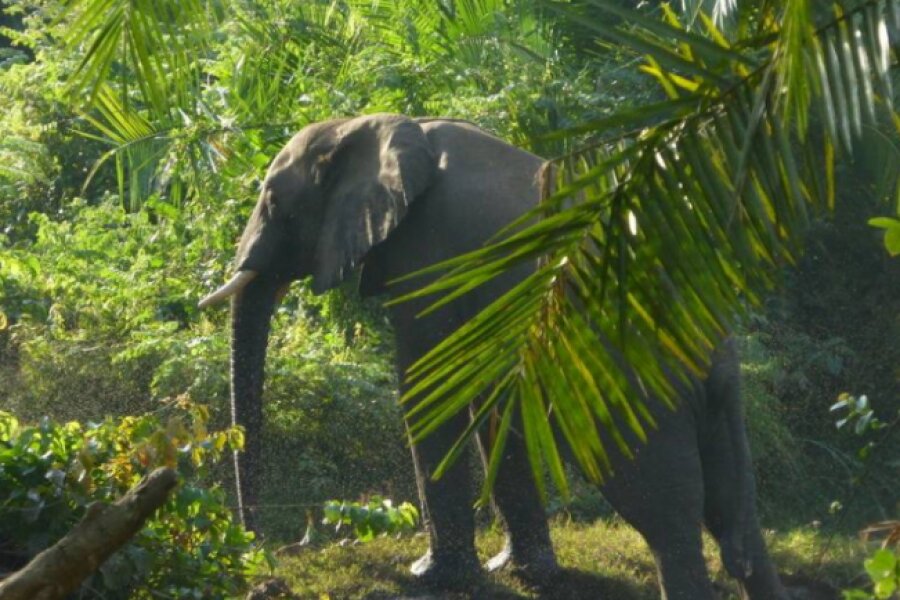
Chebera Churchura National Park
Chebera Churchura National Park is a national park located in Southern Nations, Nationalities, and Peoples' Region in the south west of Ethiopia. The park was founded by the regional government in 2005. The park covers 1,250 km² and contains four types of habitat. Most of the park, 62%, is wooded grassland dominated by elephant grass, with montane woodland comprising 29% and woodland and riparian forest.

Adadi Mariam
Adadi Mariam is a rock-hewn monolithic church located approximately 66 km southwest of Addis Ababa, Ethiopia. A popular tourist destination, the site is believed to have been built in the 12th century. Throughout its history the church has been damaged by both man-made and natural causes. Recently, restoration work to strengthen and restore the church have been done with the aid of Switzerland.
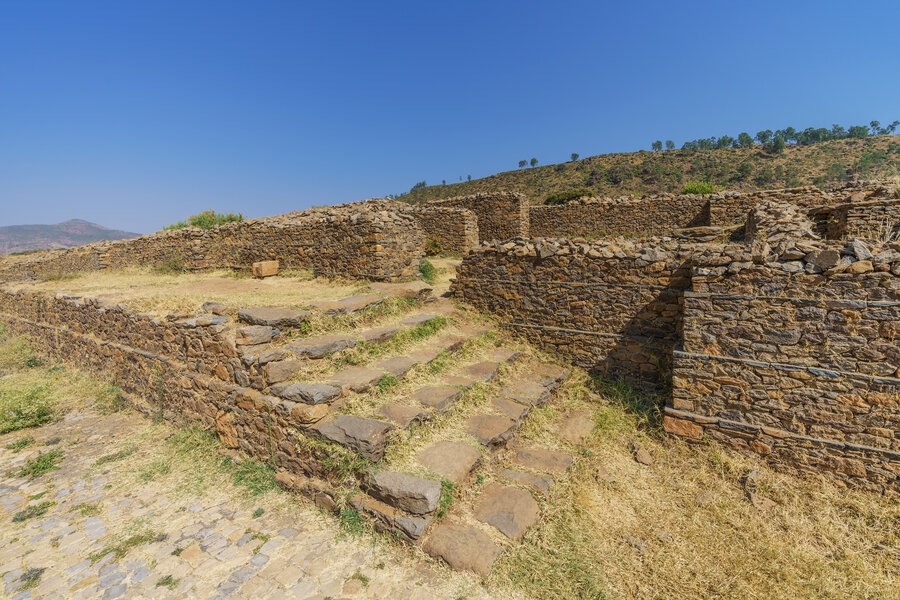
Dungur Palace (Queen of Sheba Palace)
Dungur is the ruins of a substantial mansion in Aksum, Ethiopia, the former capital city of the Kingdom of Aksum. The ruins are in the western part of Aksum, across the road from the Gudit stelae field. Dungur is known locally and popularly as the Palace of the Queen of Sheba.

Afdera
Afdera is an isolated stratovolcano in northeastern Ethiopia, located at the intersection of three fault systems between the Erta Ale, Tat Ali, and Alayta mountain ranges. There have been reports of the volcano erupting in 1907 and 1915 but morphological evidence cannot substantiate these claims. The reported eruptions were probably from the Mount Alayta volcano to the west.

Yemrehana Krestos Church
Yemrehana Krestos Church is an 11th / 12th-century Ethiopian Orthodox church located in Amhara Region, northern Ethiopia. Built of stone and wood, it was erected in the architectural tradition of the ancient Kingdom of Aksum.

Bete Medhane Alem
Biete Medhane Alem is an Orthodox underground monolith rock-cut church located in Lalibela, Ethiopia. It was built during the Zagwe dynasty. It is part of the UNESCO World Heritage Site at Lalibela. Biete Medhane Alem is home to the Lalibela Cross.

Medhane Alem Cathedral, Addis Ababa
Medhane Alem Cathedral, whose name means “Saviour of the World”, is an Ethiopian Orthodox Tewahedo cathedral in Bole Medhanealem, Addis Ababa, Ethiopia. It is the second largest cathedral in the whole of Africa and the largest in Ethiopia.

Na’akueto La’ab
Na'akueto La'ab was negus of Ethiopia, and a member of the Zagwe dynasty. According to Taddesse Tamrat, he was the son of Kedus Harbe. Richard Pankhurst credits him with the creation of the church located in a cave a half-day's journey from the town of Lalibela.

Biete Amanuel
Biete Amanuel is an underground Orthodox monolith rock-cut church located in Lalibela, Ethiopia. The edifice was built during the Kingdom of Axum. It is part of UNESCO World Heritage Site at Lalibela. Biete Amanuel is possibly the former royal chapel.

The Lower Awash Valley
The Lower Awash Valley that takes its name from the Awash River contains one of the most important groupings of paleontological sites on the African continent. Of the fossil remains found at the site, the oldest date from at least 4 million years ago, they are relevant elements in the understanding of human evolution.The most spectacular discovery came in 1974 , when 52 fragments belonging to the skeleton currently called Lucy.

The Omo remains
The Omo remains are a collection of hominin bones discovered between 1967 and 1974 at the Omo Kibish sites near the Omo River, in Omo National Park in south-western Ethiopia. The bones were recovered by a scientific team from the Kenya National Museums directed by Richard Leakey and others.

Maryam Korkor
Maryam Korkor or Debre Maryam Korkor (sometimes spelled Qorqor ) is a church located in Tigray , Ethiopia , in the Gheralta range , near Wukro . It is one of the largest rock-hewn churches in region.It is located a few hundred meters from another religious building, Daniel Korkor.Its frescoes, dating back perhaps to the XII th or XIII th century, could be among the oldest identified to date in Ethiopia 2.We can notably observe a Christ in majesty, Mary pregnant with Jesus (represented as an adult), Adam and Eve, and numerous representations of animals.

Tullu Dimtu
Tullu Dimtu is the fourth highest peak in Ethiopia after Ras Dashen, Ancua, and Kidus Yared. Tullu Dimtu is part of the Bale Mountain range in Oromia Region in southeast Ethiopia, located in the Bale National Park. It forms part of the divide between the drainage basins of the Weyib and Shebelle Rivers.

The Grand Anwar Mosque
The Grand Anwar Mosque (ታላቁ የአንዋር መስጊድ) is the main religious center for Muslims in and around the capital. Located in Addis Ketema district, which is also the site of one of the largest markets in Africa, known as Mercato.

Queen of Sheba's Bath
The Queen of Sheba is a figure first mentioned in the Hebrew Bible. In the original story, she brings a caravan of valuable gifts for the Israelite King Solomon. This tale has undergone extensive Jewish, Islamic, and Ethiopian elaborations, and has become the subject of one of the most widespread and fertile cycles of legends in the Orient.Modern historians identify Sheba with the South Arabian kingdom of Saba in present-day Yemen. The queen's existence is disputed among historians.
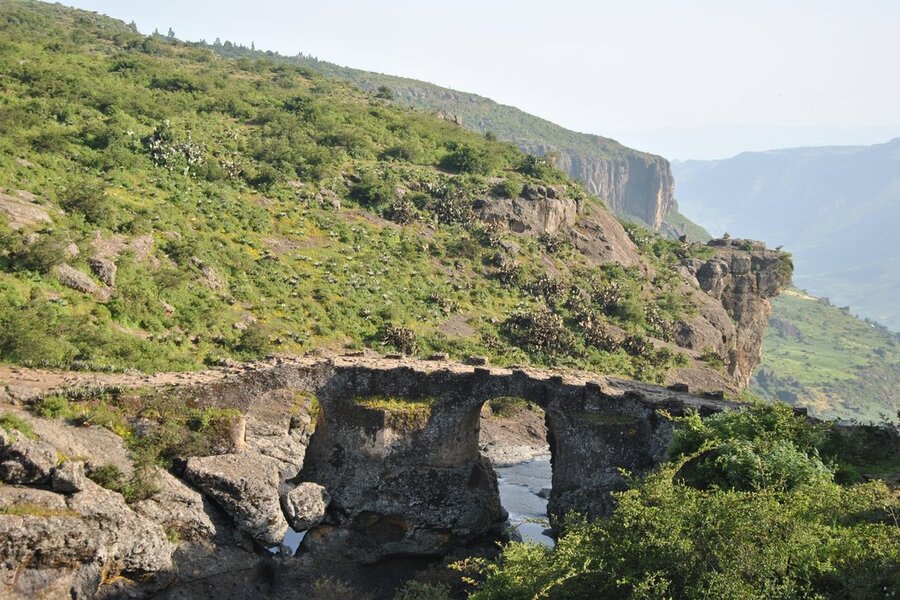
Mount Zuqualla
Mount Zuqualla is an extinct volcano in the Oromia region of Ethiopia. Situated in Ada'a Chukala woreda of the Shewa Zone, it rises from the plain 30 kilometres south of Bishoftu.

Yabelo Wildlife Sanctuary
Yabelo Wildlife Sanctuary is a protected area and wildlife sanctuary in southern Ethiopia. It is located in the Borena Zone of the Oromia Region west of the town of Yabelo, having an area of 2,500 square.

Biete Abba Libanos
Biete Abba Libanos is an underground rock-cut monolith Orthodox church located in Lalibela, Ethiopia. It was built during the Kingdom of Axum. It is part of UNESCO World Heritage Site at Lalibela.

Melka Kunture
Melka Kunture is a Paleolithic site in the upper Awash Valley, Ethiopia. It is located 50 kilometers south of Addis Ababa by road, across the Awash River from the village of Melka Awash. Three waterfalls lie downstream of the bridge across the Awash here, which provides access south to Butajira.
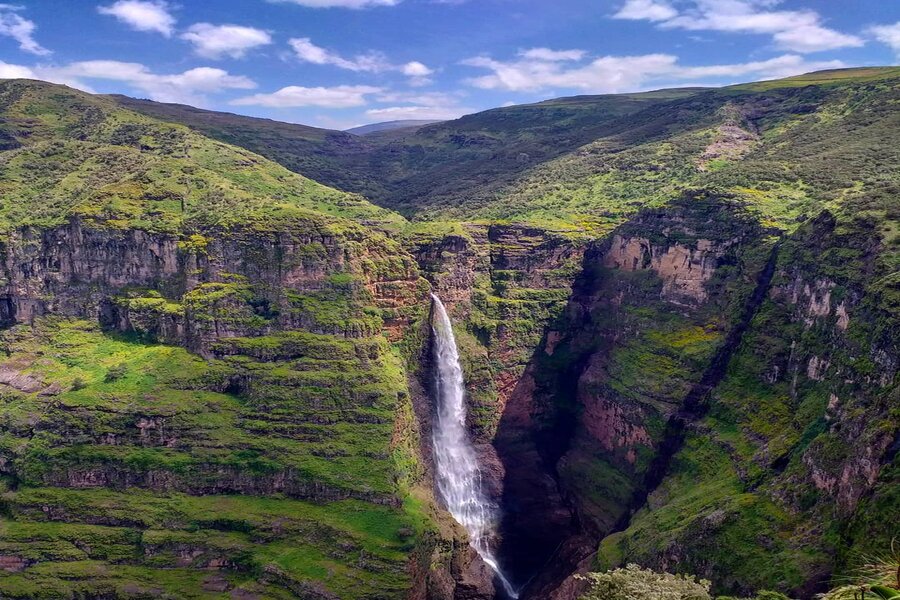
Jinbar Falls
One of the tallest waterfalls in Africa is the little known Jinbar Falls, which are more than 500 m high. The waterfall is located in one of the most dramatic locations of Simien Mountains - in Geech Abyss (Gishe Abbai). ... As the river reaches the abyss, it falls in it from an impressive canyon.

Fasilides' Bath
Fasilides (Ge'ez: ፋሲልደስ Fāsīladas, modern Fāsīledes; 20 November 1603 – 18 October 1667), also known as Fasil or Basilide,was emperor of Ethiopia from 1632 to 18 October 1667, and a member of the Solomonic dynasty. His throne name was ʿAlam Sagad (Ge'ez: ዓለም ሰገድ ʿĀlam Sagad, modern ʿĀlem Seged), meaning "to whom the world bows". He was the son of Emperor Susenyos I and Empress Sultana Mogesa (Wolete Saala) of Wagda Katata and Merhabete. Emperor Fasilides was born at Magazaz in Bulga, Shewa, before 10 November 1603. His paternal grandfather's name was also Fasilides.

tomb of adam
Christian tradition generally places the tomb of Adam in Jerusalem under the place where Jesus was crucified, called the "Cave of Treasures" and described in the Syriac "Book of the Cave of Treasures." Jewish tradition generally places the burial place of Adam in the Cave of Machpelah where Abraham and his sons are ...

Senkele Wildlife Sanctuary
Senkelle Swayne's Hartebeest Sanctuary is a protected area in the Oromia Region of Ethiopia, dedicated especially to the protection of the Swayne's Hartebeest. Covering 58 square kilometers, the reserve is located some 10 kilometers south of the Shashemene-Arba Minch road near the town of Aje. Although the sanctuary was set aside to protect the largest population of Swayne's Hartebeest in Ethiopia, a mammal endemic to the country, the original herd of 3,000 animals has dwindled to a few hundred due to poaching. Nevertheless, according to the travel writer Philip Briggs "the small size of the reserve and open terrain make it the one place in Ethiopia where Swayne's hartebeest sightings are practically guaranteed.

Unity Park
Unity Park is established in 2019. The park is located at the Grand Palace in Addis Ababa, Ethiopia, a compound that has been a seat of state for more than a century.The total land coverage of the grand palace is 40 acres and it contains myriads of historical buildings and plants that date back to the time of emperor Menelik II, the founder of the Grand Palace.

Entoto Maryam Church
Probably the oldest functional building in the vicinity of Addis Ababa, Entoto Maryam is an octagonal church constructed by Menelik II c.1882 at what was then his capital. The lovely interior, covered in traditional church paintings, can be seen only immediately after morning services, which usually end at 9am. A site museum housing a collection of religious items and ceremonial clothing from the Menelik era keeps erratic times.

lion of judah
The Lion of Judah served as the hereditary title of the Solomonic Ethiopian emperors including Yohannes IV, Menelik and Haile Selassie and was depicted on the flag of Ethiopia from 1897 to 1974. Due to its association with Haile Selassie, it continues to be an important symbol among members of the Rastafari movement.

Babile Elephant Sanctuary
The Harar Wildlife Sanctuary is a protected area in Ethiopia. It is located in the Misraq Hararghe Zone of the Oromia Region, south of Babille, with a central latitude and longitude of 8°45′N 42°38′E.
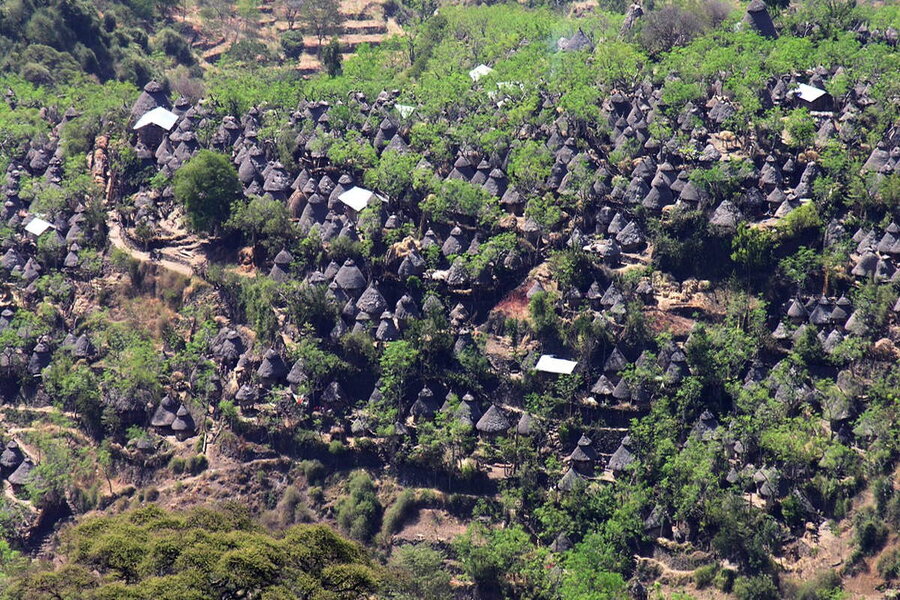
Konso Cultural Landscape
Konso (also known as Karati) is a town on the Sagan River in south-western Ethiopia. The administrative center of the Konso special woreda of the Southern Nations, Nationalities, and Peoples Region, this town has a latitude and longitude of 5°15′N 37°29′ECoordinates: 5°15′N 37°29′E and an elevation of 1650 meters. It is also called Pakawle by some of the neighboring inhabitants.

Azuwa Maryam
The thatch roof atop the church at Azuwa Maryam helps make it the best-looking church on Zege (currently Bete Maryam is the only other church with thatch), though its paintings and small museum are more ordinary. Don’t miss the religious school for priests and deacons here. Azuwa Maryam is a two-minute walk from the ferry landing – the same landing used for Ura Kidane Meret.

Yekatit 12 Monument
The Yekatit 12 is a monument in Addis Ababa commemorating victims of Italian reprisals following an attempt to kill the Marshal Rodolfo Graziani, marchese di Neghelli, Viceroy of Italian East Africa, on 19 February 1937, or Yekatit 12 in the Ethiopian calendar. It is located in the centre of Sidist Kilo Square, also called "Yekatit 12 square".

Kafta Sheraro National Park
Kafta Sheraro National Park is a national park in Ethiopia. The park is settled in Western Tigray region, in the districts of Kafta Humera and Tahtay Adiyabo. The park borders with Eritrea's Gash-Setit to the north and is traversed by the Tekezé River. Vegetation communities in the park include Acacia-Commiphora, Combretum-Terminalia, dry evergreen montane woodlands and riparian types. A total of 167 mammal species, 95 bird species and 9 reptile species have been recorded at the site.

The Ezana Stone
The Ezana Stone is a stele in Aksum, the capital of the ancient Kingdom of Aksum. The stone monument documents the conversion of King Ezana to Christianity and his conquest of various neighboring areas, including Meroë. From AD 330 to 356, King Ezana ruled the ancient Kingdom of Aksum centered in the Horn of Africa. He fought against the Nubians, and commemorated his victories on stone tablets in praise of God.

kuriftu water park
Nice water park about 40 min by road from Addis Ababa. Nice variety of water slides. The only beef I have with the place is they are over restrictive in their slides as.

Hayk Lake
Lake Hayq or Lake Haik is a freshwater lake of Ethiopia. It is located north of Dessie, in the Debub Wollo Zone of the Amhara Region. The town of Hayq is to the west of the lake. Lake Hayq is 6.7 km long and 6 km wide, with a surface area of 23 km². It has a maximum depth of 88 m and is at an elevation of 2,030 meters above sea level. It is one of two lakes in the Tehuledere woreda.

ZOMA Museum
ZOMA Museum is an environmentally conscious art institution in Addis Ababa. The mission is to act as a bridge between artists and architects from around the world to create cutting-edge ecological art and architecture. In this context, Zoma Museum is built using ancient yet still existing construction techniques.

st george gallery
One of Addis Ababa's classiest places to shop, St George has everything from antique silver crosses and contemporary textiles to wide-ranging books about Ethiopia and designer jewellery. Everything here, both modern and traditional, is exquisite and it's worth a wander.

Biete Maryam
Biete Maryam is an Ethiopian Orthodox Tewahedo Church monolithic rock-cut church in Lalibela, Ethiopia. It is part of the UNESCO World Heritage Site at Lalibela. Like the other churches of Lalibela, its precise date of construction is unknown, although it was built no earlier than the 7th century AD and no later than the 13th century AD. The churches of Lalibela, including Biete Maryam, are traditionally ascribed to having been built during the reign of the Zagwe dynasty ruler Gebre Mesqel Lalibela.
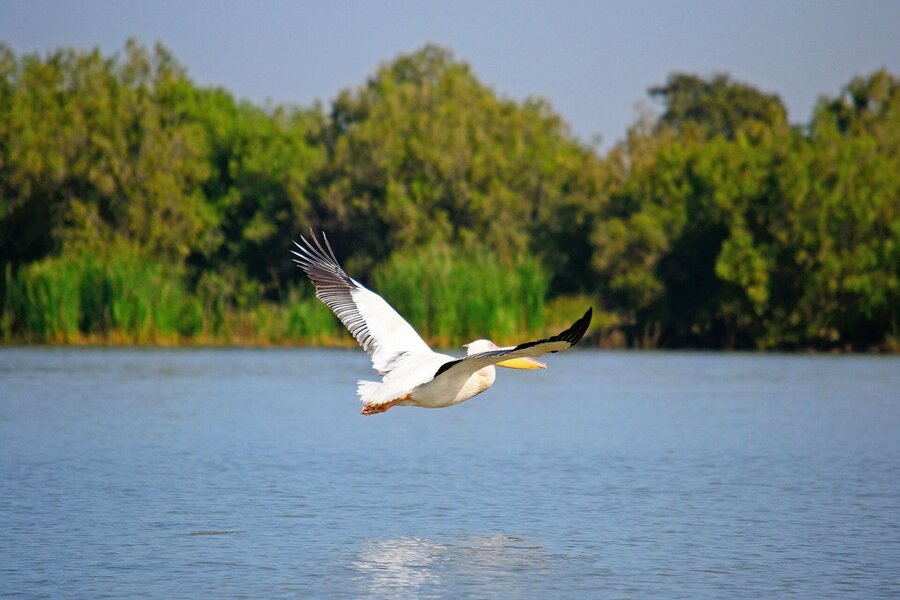
The Lake Tana Biosphere
The Lake Tana Biosphere Reserve is located in the Amhara National Regional State approximately 563 km northwest of Addis Ababa in the north-western part of Ethiopia. The biosphere reserve comprises Lake Tana, the largest lake in Ethiopia, the main source of the Blue Nile, which provides important ecosystem services. The area is a hotspot of biodiversity, internationally known as an Important Bird Area and is of global importance for agricultural genetic diversity. The area is characterized by an enormous heterogeneity of land uses and natural ecosystems. It was designated in 2014 and is administered by the ANRS Bureau of Culture, Tourism and Parks Development, under the authority of the Ethiopian Ministry of Science and Technology.

Narga Selassie
Narga Selassie is an Orthodox Tewahedo church on the western shores of Dek Island, the largest island of Lake Tana in northern Ethiopia. The name signifies "Trinity of the Rest". "Rest" refers to the place and the shade thereabouts. The church was constructed by Empress Mentewab in the late 18th century, apparently using as construction material for doors and roof a gigantic sycamore fig tree that stood at the centre of a slight elevation, now the centre of the church. Narga Selassie is fully decorated in the local style. A relief on the main entry portrays the Scottish explorer James Bruce, who visited the capital, Gondar, in the late 18th century. Narga Selassie was constructed in the classic round architectural tradition of the churches in the Lake Tana area, with the usage of stone both in the perinaeum around the church and in the compound walls.
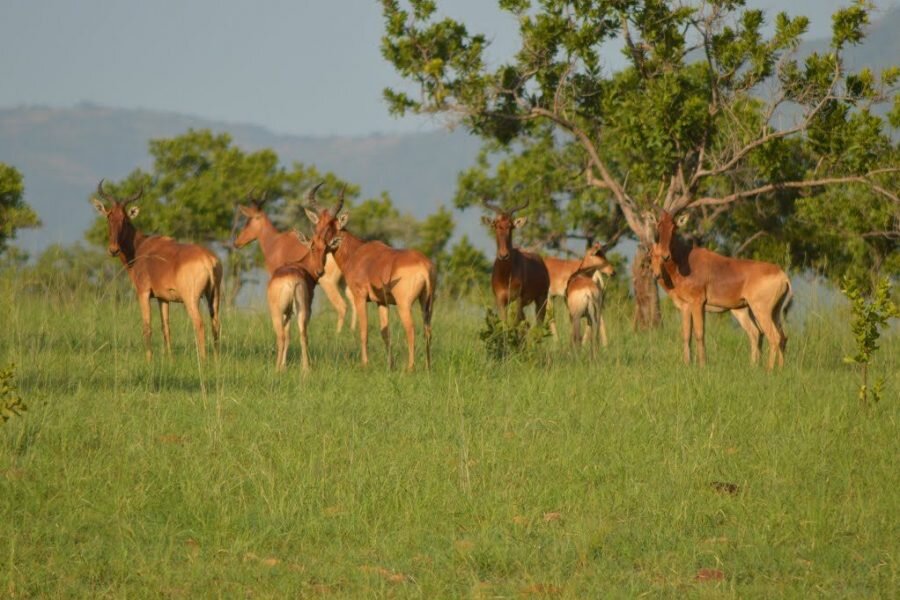
Maze National Park
Maze National Park is a national park in the Southern Nations, Nationalities, and People's Region of Ethiopia. It is 210 square kilometers in size. Elevations within the park range between 1000 and 1200 meters above sea level. Maze was founded in 2005, and is managed by the Ethiopian Wildlife Conservation Authority. Maze is noted for its population of the endangered Swayne's hartebeest, and is said to be second only to Senkelle Swayne's Hartebeest Sanctuary in importance for that subspecies.

Biete Gabriel-Rufael
Biete Gabriel-Rufael is an underground monolith rock-cut church located in Lalibela, Ethiopia. The Orthodox church was built during the Kingdom of Axum. It is part of UNESCO World Heritage Site at Lalibela. Biete Gabriel-Rufael is possibly a former royal palace, linked to a holy bakery.

Cathedral of the Holy Saviour, Adigrat
The Cathedral of the Holy Saviour, also called Adigrat Cathedral, is a Catholic church located in Adigrat, Ethiopia. It is the main place of worship of the Ethiopian Catholic Church. The cathedral is the mother church of the Eparchy of Adigrat. It belonged to the archeparchy of Addis Ababa, which was elevated to its current status in 1961 by Pope John XXIII through the bull "Quod Venerabiles". The cathedral was built on a site called Welwalo, which was reserved after World War II for the construction of a church, it was the first parish and, after the establishment of the Eparchy and with some additions, became the cathedral being dedicated to the Holy Savior on 19 April 1969, was realized on the basis of an Italian project including the great mural Giudizio Universale of the Ethiopian artist Afewerk Tekle.
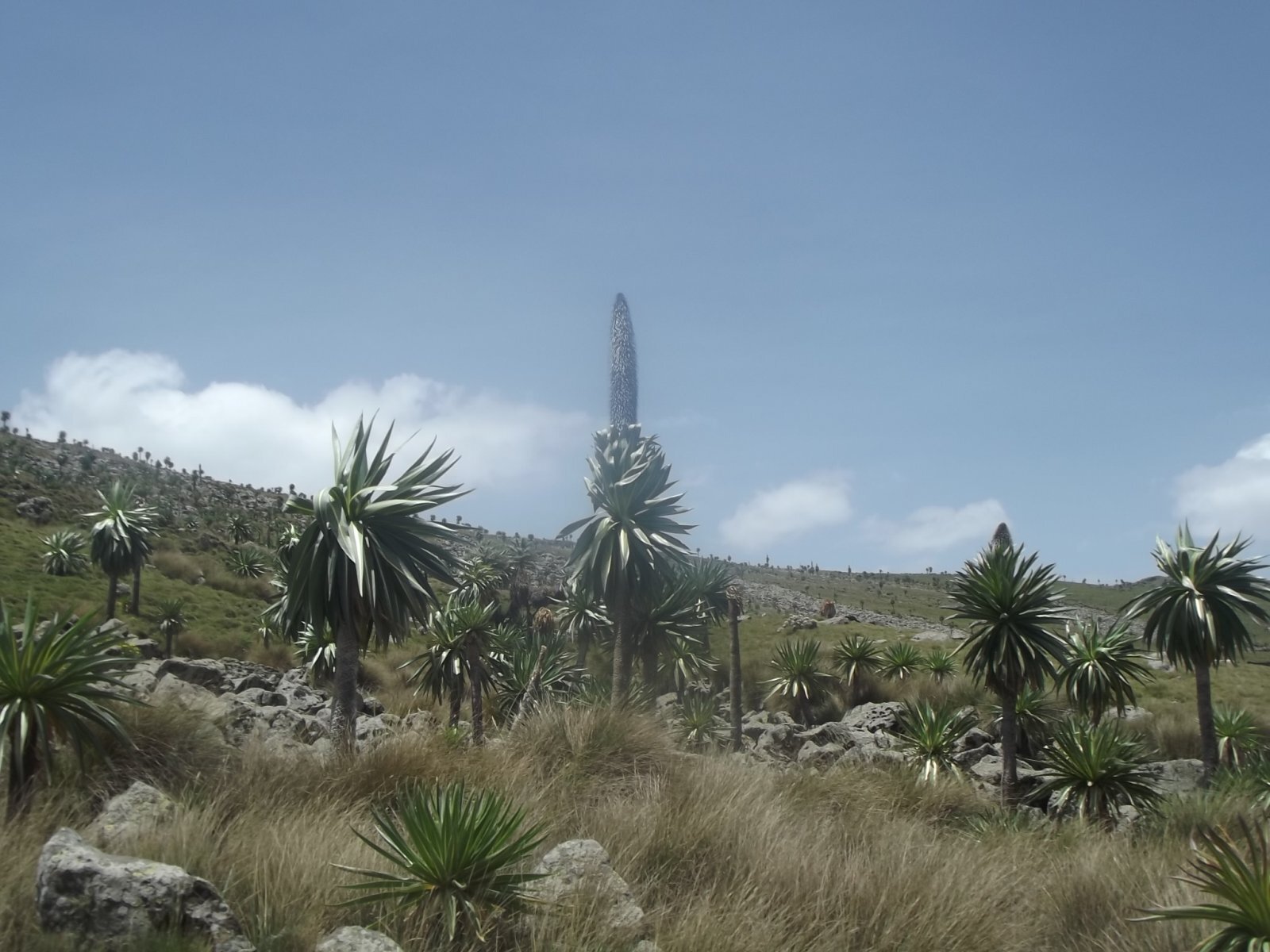
Mount Guna
Mount Guna is a mountain and shield volcano located near the cities of Nefas Mewcha and Debre Tabor, in the northern Amhara region of Ethiopia. It is the highest point in the South Gondar Zone, with an elevation of 4,120 metres above sea level.
